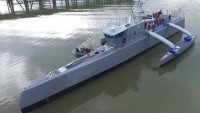US Developing ‘Spike’ Mini-Missile to Shoot-down Aerial Drones
| Arthur Dominic Villasanta | | Feb 03, 2017 08:40 AM EST |
(Photo : US Navy) The mini-missile called Spike.
The U.S. Navy is testing a tiny guided missile only 64 cm (2 feet, 1 inch) long to shoot-down unmanned aerial vehicles (UAVs), more commonly called aerial drones, either individually or in a swarm.
The "NAVAIR Spike" developed by the U.S. Naval Air Warfare Center Weapons Division (NAVAIR) is a newly developed miniature, lightweight precision guided missile costing only $5,000 first designed for use against ground targets.
Like Us on Facebook
It was intended to take out "asymmetric targets" such as insurgents in urban areas more economically and with a lesser chance of inflicting collateral damage compared to the AGM-114 Hellfire air-to-ground missile costing over $100,000 each.
The U.S. Navy calls Spike a "forward-firing miniature munition." Spike being developed by a team of engineers whose goal is to provide a cost-effective weapon that can counter emerging threats with capabilities that other, more expensive weapons can't.
Spike carries a 450 gram explosively former penetrator (EFP) warhead and has a maximum range of over three kilometers.
In December 2016, two Spikes with proximity fuses demonstrated a capability to shoot down UAVs. In the first test, a Spike destroyed an Outlaw UAV with a direct hit. In the other, Spike used a proximity fuze to shoot down a second Outlaw.
Spike first conducted an interception of an airborne target in June 2013, demonstrating its potential as a potential anti-UAV precision weapon. That capability was verified in December 2016.
During the counter-UAV live fire test in 2013, the Spike launcher was mounted on a radar-queued gimbal, which maintained the target in the missile's field of view while the Spike operator acquired, tracked and engaged the target.
After the test, the U.S. Army's Armament Research, Development and Engineering Center requested the Spike team's participation in a transport convoy protection line of defense using a similar gimbal system.
The Army provided the proximity fuze enabled Spike to explode on contact or near the target. In December, the Spike team demonstrated the effectiveness of both activation modes in destroying both Outlaw UAVs.
NAVAIR said its project engineers continue to make improvements to the fire control suite. Algorithm will also be updated to improve missile accuracy.
Spike will be used by the Navy against the increasing threat of small boat swarms often referred to as the fast attack craft (FAC) and fast inshore attack craft (FIAC).
Spike has recorded direct hits against moving FIAC threats in separate test events on the NAVAIR Point Mugu sea range.
TagsU.S. Navy, unmanned aerial vehicles, NAVAIR Spike, U.S. Naval Air Warfare Center Weapons Division, asymmetric targets, forward-firing miniature munition, Outlaw UAV, aerial drone
©2015 Chinatopix All rights reserved. Do not reproduce without permission
EDITOR'S PICKS
-

Did the Trump administration just announce plans for a trade war with ‘hostile’ China and Russia?
-

US Senate passes Taiwan travel bill slammed by China
-

As Yan Sihong’s family grieves, here are other Chinese students who went missing abroad. Some have never been found
-

Beijing blasts Western critics who ‘smear China’ with the term sharp power
-

China Envoy Seeks to Defuse Tensions With U.S. as a Trade War Brews
-

Singapore's Deputy PM Provides Bitcoin Vote of Confidence Amid China's Blanket Bans
-

China warns investors over risks in overseas virtual currency trading
-

Chinese government most trustworthy: survey
-

Kashima Antlers On Course For Back-To-Back Titles
MOST POPULAR
LATEST NEWS
Zhou Yongkang: China's Former Security Chief Sentenced to Life in Prison

China's former Chief of the Ministry of Public Security, Zhou Yongkang, has been given a life sentence after he was found guilty of abusing his office, bribery and deliberately ... Full Article
TRENDING STORY

China Pork Prices Expected to Stabilize As The Supplies Recover

Elephone P9000 Smartphone is now on Sale on Amazon India

There's a Big Chance Cliffhangers Won't Still Be Resolved When Grey's Anatomy Season 13 Returns

Supreme Court Ruled on Samsung vs Apple Dispute for Patent Infringement

Microsoft Surface Pro 5 Rumors and Release Date: What is the Latest?












